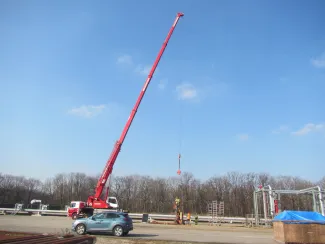Research into deep geothermal energy on the Balmatt site
In February 2021, the Board of Directors of VITO decided to restart the deep geothermal power plant on the Balmatt site in Mol for a one-year research programme. The main objective is to better understand the hydraulic and seismological characteristics of the subsurface reservoir.

Balmatt deep geothermal power plant 2.0
Preliminary research has led to a number of adjustments to the geothermal power plant on the Balmatt site and to the seismometer network. The main aim of the modifications is to enable more accurate research into the cause of the induced vibrations and to assess the risks of surface vibrations as accurately as possible.
First and foremost, the plant is now equipped with a voltage protection device to deal with the consequences of a power failure. In addition, a pressure maintenance system has been installed at the injection well, which is currently being fine-tuned. Because the release of gas from the pumped water can also lead to pressure fluctuations, the VITO researchers have reduced the chance of degassing occurring in the injection well by increasing the operating pressure and extending the injection tubing. Based on the observation that a higher pump flow caused an increased injection pressure, the pump was replaced with a type that can deliver lower flows than the original pump.
Refined seismometer network
An extremely important modification was the refinement of the seismometer network. The researchers can now rely on 16 seismometers, positioned at different locations and depths, ranging from the ground surface (close to the centre of Dessel) and from 30 m to 2 km deep.
The extension was necessary in order to:
- detect more low magnitude vibrations (from ML corr 0.0);
- determine the location of the vibrations more accurately;
- gain a better understanding of the source mechanisms;
- obtain information on the strength of the vibrations at the surface;
- to find out how often vibrations of a certain magnitude occur (magnitude-frequency relationship).
The more detailed information obtained in this way should provide a better understanding of the seismological behaviour of the deep subsurface beneath Mol and Dessel, the causes of the microseismicity, and the relationship between the activities at the geothermal site and the vibrations, and ultimately allow a better assessment of the seismic risk.
Towards a safe sustainable energy source
Between February and April 2021, final preparations were made for the restart. The first tests took place on 20 April. Initially, the tests were intended to check that the installations and components were still functioning properly. Gradually, the system pressure of the installations was increased to more than 50 bar in order to prevent the release of gases from the pumped brine.
Step by step, the test phases became longer and the flow rate increased. The maximum flow rate at which the brine was produced and injected was 25 m³/hr. This resulted in a maximum injection pressure of approximately 90 bar. The last and so far longest test phase started at the end of November 2021 and is still ongoing in mid-February 2022. The longer test phases allow more reliable estimates to be made of the flow characteristics of the reservoir. In addition, the researchers evaluate the adjustments already made to the plant.
The extensive seismometer network detects more and smaller vibrations. Most of the vibrations are very small. The location and magnitude of only 54 vibrations could be determined. Usually the magnitude lies between ML corr 0.0 and -0.5. Four times a vibration with ML corr 0.1 was registered, while the largest vibration so far has a magnitude of ML corr 0.6. The latter occurred on 8 January 2022.


